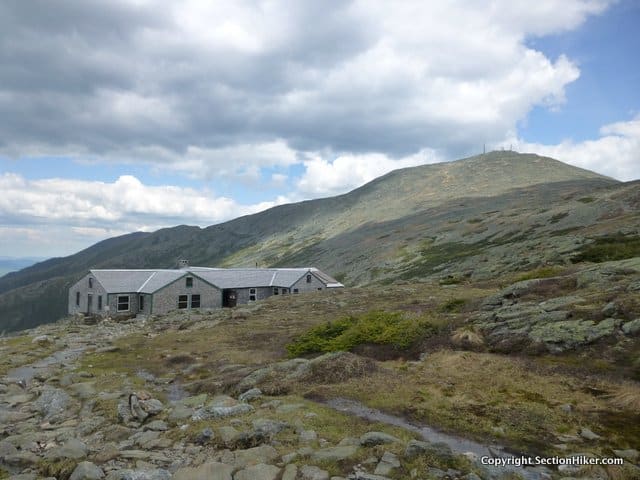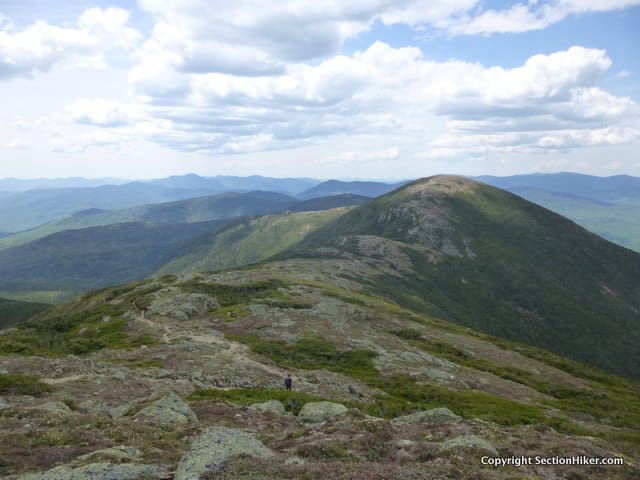
- Overview GeoPDF Map (Download) [1:50,000]
- GPX File (Download) – Trails only (after downloading this file, rename it so it has a ".gpx" file extension)
A 2-3 day, 22 mile scenic loop that travels up the Dry River Valley, climbing the Oakes Gulf headwall, to a set of alpine lakes at the foot of Mt Washington. From here, hikers climb 4 four thousand footers in sequence: Mt Monroe, Mt Eisenhower, Mt Pierce, and Mt Jackson, before descending the Webster Cliff Trail back to Crawford Notch. This route has close to 10 miles of above-treeline hiking and unparalleled views of Mt Washington, the Dry River Wilderness, and Crawford Notch.
Rating/Difficulty
*****/4 out of 5
Distance/Elevation Gain
22 miles w/6000′ of cumulative elevation gain
White Mountain 4000 Footers
- Monroe
- Eisenhower
- Pierce
- Jackson
Recommended Duration
2-3 days
Season
mid-June thru October
Permits Required
None.
Regulations
Backcountry Camping Regulations for the White Mountain National Forest, specifically no camping above treeline where trees are less than 8′ in height (except on two feet of snow.)
A substantial portion this route passed through the Dry River Wilderness Area. Please observe all wilderness area restrictions.
Trailhead Directions
Webster Cliff Trailhead Directions (44.10148, -71.23164) – Parking is available for a few cars across Rt 302 from the trail head. NH state law requires that all tires be off the pavement. This is a busy trailhead that has a lot of traffic passing by, so parked cars are generally safe.
Trail Sequence
The route follows the following trails in sequence. Refer to AMC White Mountain Trail Map 1 – Presidentail Range (2017 ed), which is the best waterproof map available for this region, although I'd recommend buying the complete AMC White Mountain Waterproof Map Set (2017 ed) rather than one map at a time. More detailed trail descriptions can be found in the AMC White Mountain Guide (2017 ed), which is considered the hiking bible for the region. Take photos of the pages using your phone for easy reference, instead of carrying the entire book with you on hikes.
- Webster Cliff Trail – 0.3 miles
- Saco River Trail – 1.7 miles
- Dry River Trail – 9.1 miles
- Crawford Path – 0.1 miles
- Monroe Summit Loop – 0.7
- Crawford Path – 1.5 miles
- Mt Eisenhower Loop – 0.8 miles
- Crawford Path – 1.2 miles
- Webster Cliff Trail – 6.8 miles
Scenic Highlights
The following list provides cumulate distances on the route to each view or landmark.
- 3.2 miles – Dry River Suspension Bridge
- 7.8 miles – Dry River Shelter #3
- 11.0 miles – Lakes of the Clouds (two alpine ponds)
- 11.1 miles – AMC Lakes of the Cloud Hut
- 11.2 miles – Mount Monroe Summit
- 13.1 miles – Mt Eisenhower Summit Cairn
- 14.7 miles – Mt Pierce Summit
- 17.1 miles – Mt Jackson Summit
- 18.4 miles – Mt Webster Summit
Camping/Shelter Options

- USFS Wilderness Campsite (Free) – at the bottom of the Mt Eisenhower Trail on the west side of the Dry River. Requires fording the Dry River to reach (and get back to the other side of the river the next day), which can be difficult in high water. Look for an ankle-high wooden marker with a tent carved in it. Not marked on maps because it's not a permanent campsite.
- USFS Wilderness Campsite (Free) – just north of the Isolation Trail West/Dry River Trail junction. Look for a spur trail with an ankle-high wooden on the west side of the trail. Not marked on maps because it's not a permanent campsite.
- USFS Dry River Shelter #3 (Free) – Lean-to, limited space for tents
- AMC Lakes of the Clouds Hut ($$$) – Advance reservations recommended
- AMC Mizpah Spring Hut ($$$) – Advance reservations recommended
- AMC Nauman Tent Platforms ($) – Caretaker in Summer.
- AMC Highland Center ($$$) – Advance reservation recommended.
Water
Natural water sources are plentiful in the White Mountains although you may need to descend to them from ridgelines along side trails if you run short. The longest stretch of dry trail on this route runs from the Nauman Tentsite and Mizpah Spring Hut to the base of the Webster Cliff Trail in Crawford Notch. However, when the AMC Huts are in season, anyone can stop in and resupply their water for free from the small sink located near the hut kitchen. In any case, carry a detailed topographic map with you and don't rely on the overview map provided with this trip description to find water sources.
I also recommend purchasing the Presidential Range Map in Guthooks Guide's White Mountains and New England Trails Smartphone App (IOS, Android) which is a GPS guide to all of the trails, trailhead, shelters, campsites, views, and water sources in the White Mountains National Forest. I use it all the time and it is much more complete and current than using the maps bundled with the Gaia Smartphone App.
Weather Cautions
This route is sensitive to seasonal and weather conditions which can make it hazardous. There is a river ford at the Dry River Shelter that can be hazardous in high water. Wait a few days for water levels to drop after a significant rainfall (more than 1-2″) before hiking the Dry River Trail. The second half of the route from Lakes of the Clouds to Crawford Notch has close to 10 miles above-treeline travel and is hazardous to hike if thunderstorms or high winds are forecast. The top of the Dry River Trail in Oakes Gulf is usually clear of winter snow by mid-June, but patches of snow may linger into July.
On the Trail
Cross Rt 302 and begin the trip on the Webster Cliff Trail. Pass the first Saco River Trail junction at 0.2 miles on your left (running north) and continue to the second one at 0.3 miles on your right (running south). Follow the Saco River Trail and proceed for 1.7 miles through forest, parallel to the Saco River. This is section of the river is near its headwaters at the top of Crawford Notch, so the stream is quite small here. On your left you'll soon see the tail of a large land slide that fell from Webster Cliff, which towers above, though hidden by the tree canopy.
Turn left at the junction with the Dry River Trail, heading in an easterly direction. You'll be on this trail for the next 9.1 miles until you reach the AMC's Lakes of the Clouds Hut. The Dry River Trail is in the Presidential-Dry River Wilderness, and the trail can be challenging to follow in places because it's purposefully not as well maintained or signed as other trails.

The trail also suffered major damage from Hurricane Irene in 2011 which resulted in numerous landslides and stream bank erosion, that are still in evidence today. While the trail has been rerouted over and past the landslides (that wiped it out), the newer segments of trail aren't as well marked by traffic as the older sections that were untouched by the storm. Don't let this deter you from backpacking this route, especially since this is one of the most remote (lost world) spots in the White Mountains, despite its proximity to Mt Washington and Crawford Notch.

In 1.2 miles, you'll come to the Dry River Suspension Bridge and cross over it to the other side of the river. This is a good spot to linger and take in the sublime magnificence of the Dry River, its huge boulders, eddies, pools, and rapids. You'll catch glimpses of the river as you hike upstream, from the river's edge and high above it, looking down its steep side slopes. Fly fishermen will recognize all the signs of a fun river to fish. Just make sure you have a New Hampshire fishing license and adhere to daily limits, since the native trout are on the small side and subject to enormous environmental pressure in this small watershed.

Finish crossing the bridge and turn left at the end, hiking up the Dry River Trail towards Mt Washington. After 1.2 miles, you'll pass a sign to the Mt Clinton Trail on your left (and stay on the Dry River Trail). Hiking the Mt Clinton Trail requires a ford across the Dry River followed by a climb to the Mizpah Hut, below Mt Pierce, formerly named Mt Clinton. The Mt Clinton Trail was for many years one of the hardest trails to follow in the White Mountains due to lack of maintenance. It has recently been taken over by a new trail adopter, who I'm told has made it easier to follow.
Continue along the Dry River Trail. In 2.0 miles, you'll come to a trail junction with the Isolation Trail, which provides access to Mt Isolation on a less travelled route. Pass through the junction and continue on the Dry River Trail, continuing straight past the Mt Eisenhower Trail on your left, 0.3 miles farther along. The Mt Eisenhower Trail also requires a ford, before climbing to the Crawford Path below Mt Eisenhower.
In 0.2 miles, you'll ford the Dry River to the north side, near the Dry River Shelter #3, shown below. If you don't have previous experience fording rivers, this crossing can be a little intimidating. But it's not a wide crossing or a high volume crossing (except after significant rainfall) because it's so high up the river valley, where there's less water flowing into the watershed. You can't rock hop it though. Unbuckle your back pack belt so you can jettison your pack if you fall (and it fills up with water dragging you under) and walk across. I'd recommend keeping your boots or shoes on to protect your feet and ensure solid footing as you cross.

In 0.7 miles, you'll arrive at the Dry River Shelter #3, which is a good place to call it a day and rest before the climb up the Oakes Gulf headwall at the top of the Dry River Valley. There's limited space for tents here, but the shelter is still in decent shape, and there are lots of trees around to hang a hammock. Dry River Shelter #1 and #2 were removed years ago and #3 will be next when it's in need of major repairs. Though controversial, the USFS is removing lean-tos in Wilderness Areas to comply with the Wilderness Act, which prohibits most man-made structures in these areas.

When you leave Dry River Shelter, the trail enters a heavily wooded area called Oakes Gulf which is subject to blowdowns and lingering snow that can make the trail hard to follow, particularly in spring before the trail crews have visited. Snowmelt also often flows down portions of the trail which can be muddy too, early in the season. The trail climbs the headwall until it reaches height-of-land on the Southwest shoulder of Mt Washington. After leaving the Dry River Shelter, this is a not-so-insignificant 2400′ ascent, so take your time.
Oakes Gulf is a sibling to the other great ravines that surround Mt Washington, including Tuckerman Ravine, Huntington Ravine, The Great Gulf, and the Ammonoosuc Ravine. They all have their own headwall trails too.

When you crest the headwall, you pass a large cairn. Just beyond it are two alpine tarns called the Lakes of the Clouds, and beyond them, the AMC Lakes of the Clouds Hut. Even if you're not a guest, I'd encourage you to pop into the hut for a visit. There's water available here, snacks, bathrooms, and lots of information scattered around. This hut houses up to 96 guests per night and serves them two meals per day, so it's pretty cushy.
There are also weather instruments in the hut and an updated forecast posted which are worth checking before you proceed on the second half of this journey. If the wind is blowing over 40 miles per hour at the hut, you're going to have a long day hiking down the Southern Presidential Range back to Crawford Notch. If there are thunderstorms in the area, I'd recommend descending off the ridge completely because it's completely exposed without any cover and there's a very real risk of being struck by lightning directly or indirectly by ground current transmitted through the rocks. I don't mean to scare you off this route, but it is important to plan this hike around a few good weather days, both in the Dry River Valley and up above treeline. The views are also much better.

If you do need to boogie off the ridge, it's best to head down the west side rather than the east because it has better road access and requires a shorter hike out if you decide to bail. The best west-side escape routes are the Ammonoosuc Ravine Trail, the Edmands Path, and the Mizpah Cutoff/Crawford Path. There's also parking at the end of all of these trails if you decide to spot a car there.

Leaving the hut, you'll follow the Crawford Path 0.1 miles to the Monroe Loop trail, which climbs Mt Monroe and a sub-peak behind it, before rejoining the Crawford Path. Monroe an easy 350′ climb from the hut, despite the fact that it's the fourth highest 4000 footer, at 5384′. That's the beauty of a ridgeline walk and the secret to hiking multiple 4000 footers on one hike. Once you climb a ridgeline, you can pick off one peak after another, on the same hike, with relatively little incremental effort. Many of the 4000 footers are on common ridgelines and its a thrill to bag several on the same walk. If you're a purist, there are other White Mountain peakbagging lists that only credit you one peak per hike, so you can only count one at a time. Those are fun too!

The Monroe Loop Trail rejoins the Crawford Path in 0.7 miles at a well-marked junction. Follow the Crawford Path (heading southwest) for 2.2 miles to the Eisenhower Loop Trail, which climbs another 350′ to the large rock cairn that marks the Eisenhower summit. Mt Eisenhower is named after the former US President Dwight Eisenhower, presumably because they share the same bald dome.
Continue past the Eisenhower cairn and rejoin the Crawford Path and follow it 1.7 miles to the summit of Mt Pierce, a rocky summit which juts above treeline. The views are almost continuous along this stretch, so take time to stop and day-dream.
From the just below the summit of Mt Pierce, take the Webster Cliff Trail 0.9 miles to the Mizpah Hut, where you can also pop in for water, a bathroom break, or refreshments. Baked goods and left overs are usually available for purchase in the huts during the day and can provide a welcome break. Hint: buy the fresh-baked bread that's often available. While a big slice of bread costs money, the butter is often free, so lather it on for some extra calories.
The AMC's Nauman Tentsite is situated next to the Mizpah Spring Hut and is the only designated campsite along the Southern Presidential Ridge where you can camp overnight. The tentsite is overseen by a caretaker in season and a small fee is charged.

Continue southwest down the Webster-Cliff Trail to Mt Jackson which is another knobby peak that just pokes above treeline. Continue southwest along the Webster-Cliff Trail for 1.3 mile to Mt Webster. DO NOT take the Jackson Branch or Webster Branch Trails from Mt Jackson, but remain in Webster-Cliff Trail. Mt Webster is at the top of the Webster Cliff, along the east side of Crawford Notch. To your immediate west, you can see the slide scarred east face of Mt Willey on the other side of a great abyss, as well as the valley below.

Follow the Webster-Cliff Trail, turning left (south) onto it after Mt Webster, and hike along the top of the cliff, before descending back to the valley floor. This section has several rocky scrambles, so take your time descending and don't hesitate to scooch down on your butt if circumstances warrant it. After 3.4 miles, you'll return to the valley floor and the start of your journey.
Safety Disclaimer
This trip plan can not alert you to every hazard, anticipate your experience, or limitations. Therefore, the descriptions of roads, trails, routes, shelters, tent sites, and natural features in this trip plan are not representations that a particular place or excursion will be safe for you or members of your party. When you follow any of the routes described on SectionHiker.com, you assume responsibility for your own safety. Under normal conditions, such excursions require the usual attention to traffic, road and trail conditions, weather, terrain, the capabilities of your party, and other factors. Always check for current conditions, obey posted signs, and Backcountry Camping and Wilderness Area Regulations. Hike Safe and follow the Hiker responsibility code. Disclosure: SectionHiker.com receives affiliate compensation from retailers that sell the products we recommend or link to if you make a purchase through them. When reviewing products, we test each thoroughly and give high marks to only the very best. Our reputation for honesty is important to us, which is why we only review products that we've tested hands-on. Our mission is to help people, which is why we encourage readers to comment, ask questions, and share their experiences on our posts. We are independently owned and the opinions expressed here are our own.The post A Southern Presidential Loop Trip Plan: Backpacking the 4000 Footers Guidebook appeared first on Section Hikers Backpacking Blog.
from Section Hikers Backpacking Blog http://ift.tt/2oJbYjM





 The hardest thing a freelancer can do is take action.
The hardest thing a freelancer can do is take action.














